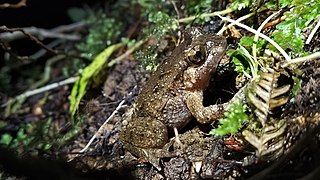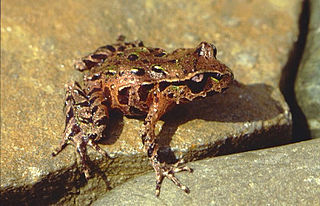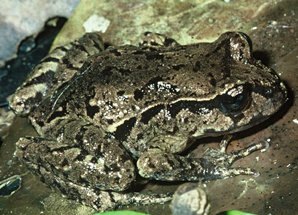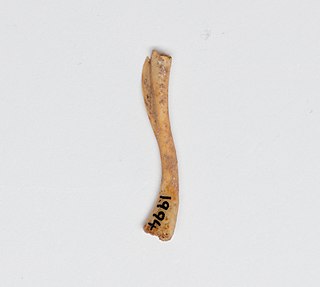
Moa are an extinct group of flightless birds formerly endemic to New Zealand. There were nine species. The two largest species, Dinornis robustus and Dinornis novaezelandiae, reached about 3.6 m (12 ft) in height with neck outstretched, and weighed about 230 kg (510 lb) while the smallest, the bush moa, was around the size of a turkey. Estimates of the moa population when Polynesians settled New Zealand circa 1300 vary between 58,000 and approximately 2.5 million.

Leiopelma is a genus of New Zealand primitive frogs, belonging to the suborder Archaeobatrachia. It is the only genus in the monotypic family Leiopelmatidae. The leiopelmatids' relatively basal form indicates they have an ancient lineage. While some taxonomists have suggested combining the North American frogs of the genus Ascaphus in the family Ascaphidae with the New Zealand frogs of the genus Leiopelma in the family Leiopelmatidae, the current consensus is that these two groups constitute two separate families. The four extant species of Leiopelmatidae are only found in New Zealand.

The bush moa, little bush moa, or lesser moa is an extinct species of moa from the family Emeidae.

Hochstetter's frog or Hochstetter's New Zealand frog is a primitive frog native to New Zealand, one of only four extant species belonging to the taxonomic family Leiopelmatidae. They possess some of the most ancient features of any extant frogs in the world.

Archey's frog, Leiopelma archeyi, is an archaic species of frog endemic to the North Island of New Zealand. It is one of only three extant species belonging to the taxonomic family Leiopelmatidae. It is named after Sir Gilbert Archey, the former director of the Auckland Institute. The holotype is held at the Auckland War Memorial Museum. It is found only in the Coromandel Peninsula and near Te Kuiti in the North Island of New Zealand. This species, along with others in the family, have changed little over the past 200 million years, thus they represent "living fossils".

The Hamilton's frog(Leiopelma hamiltoni) is a primitive frog native to New Zealand, one of only four extant species belonging to the family Leiopelmatidae. The male remains with the eggs to protect them and allows the tadpoles to climb onto his back where they are kept moist. It is named in honour of Harold Hamilton the collector of the type specimen. The holotype is in the collection of the Museum of New Zealand Te Papa Tongarewa.

The Maud Island frog is a primitive frog native to New Zealand, one of only four extant species belonging to the family Leiopelmatidae.

Hoplodactylus delcourti, also commonly known as kawekaweau, Delcourt's sticky-toed gecko and Delcourt's giant gecko, is an extinct species of lizard in the family Diplodactylidae. The species was the largest known of all geckos, with a snout-to-vent length (SVL) of 370 mm (14.6 in) and an overall length of at least 600 mm (23.6 in). Scientifically it is known from just one taxidermied specimen that was rediscovered unlabelled in a museum in France. The origin of the specimen is unknown; New Zealand and New Caledonia have been suggested. The idea that Hoplodactylus delcourti is the kawekaweau of Maori tradition has been contested.
The long-billed wren was a species of New Zealand wren endemic to the South Island of New Zealand. It was the only species in the genus Dendroscansor. It shares the name "long-billed wren" with the Brazilian bird Cantorchilus longirostris.
Trevor Henry Worthy is an Australia-based paleozoologist from New Zealand, known for his research on moa and other extinct vertebrates.

Pachyplichas is a genus containing two extinct species of New Zealand wren, a family of small birds endemic to New Zealand.
The Viti Levu scrubfowl, also known as the Fiji scrubfowl or lost megapode, is an extinct megapode that was endemic to Fiji. The epithet amissus, from Latin "lost", refers to its extinction. Subfossil remains were collected from the Udit cave at Wainibuku on the island of Viti Levu in October 1998 by Trevor Worthy, G. Udy and S. Mataraba, and described by Worthy in 2000. The holotype is held by the Museum of New Zealand.
Megavitiornis altirostris is an extinct, flightless, giant stem-galliform bird that was endemic to Fiji, it is the only known species in the genus Megavitornis. Originally thought to be a megapode, more recent morphological studies indicate a close relationship with Sylviornis of New Caledonia, with both genera belonging to the family Sylviornithidae outside of the Galliformes crown group. It is likely that it became extinct through overhunting shortly after the colonisation of the Fiji Islands by humans.
Leiopelma auroraensis, known as the Aurora frog, is an extinct species of frog that was found in New Zealand. One subfossil of the Aurora frog has been discovered in the Aurora Cave, Fiordland, New Zealand. It measured about 60 mm from the snout to the vent. It is named after the Aurora Cave for where it was found. The other extinct New Zealand frogs are Markham's frog and Waitomo frog. Aurora frog probably was a local form that had evolved from the more widely distributed Markham's frog.

The St Bathans fauna is found in the lower Bannockburn Formation of the Manuherikia Group of Central Otago, in the South Island of New Zealand. It comprises a suite of fossilised prehistoric animals from the late Early Miocene (Altonian) period, with an age range of 19–16 million years ago.

The Manuherikia Group is a fluvial-lacustrine sedimentary fill in the Central Otago area of New Zealand, at the site of the prehistoric Lake Manuherikia. The area consists of a valley and ridge topography, with a series of schist-greywacke mountains at roughly ninety degrees to each other. The Manuherika Group occurs in the current basins, and occasionally on the mountains themselves.

Markham's frog is one of three extinct New Zealand frog species, the others being the Aurora frog and Waitomo frog. Subfossil bones used to describe the species were discovered at Honeycomb Hill Cave, South Island, New Zealand, but it once occurred on both South and North Islands. It is estimated that it grew between 50 and 60 mm from snout to vent and it appears to have been a very robust animal.

The Northland skink is an extinct species of skink which was endemic to the Northland Region of North Island, New Zealand. It is known from late Holocene subfossil remains.
The Waitomo Caves Discovery Centre is a museum located in the town of Waitomo in the North Island of New Zealand. The museum is also referred to as the Waitomo Caves Discovery Centre, the Waitomo Museum of Caves and the Waitomo Education Centre.













